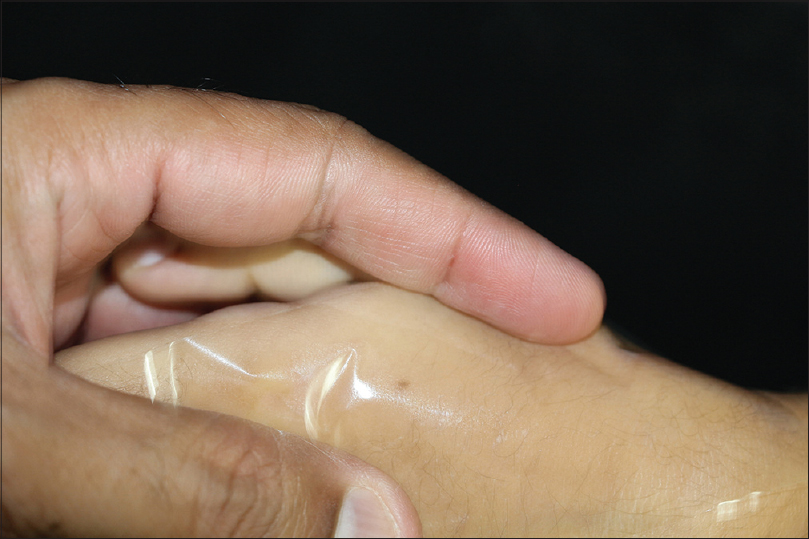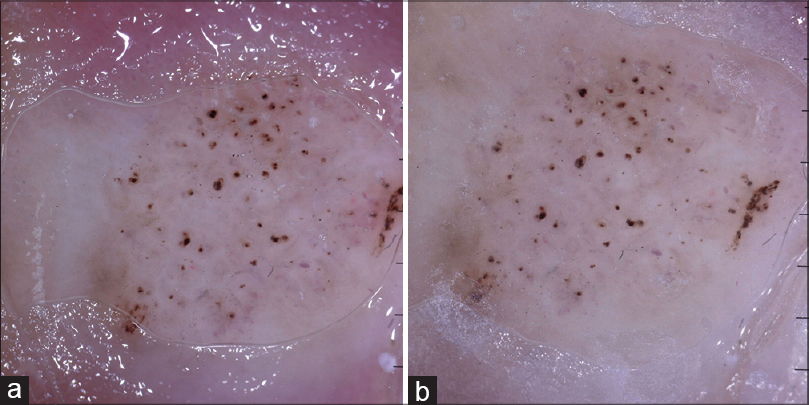Translate this page into:
Using transparent adhesive tape to prevent cross infection during contact dermoscopy
Correspondence Address:
Feroze Kaliyadan
Department of Dermatology, College of Medicine, King Faisal University, Hofuf
Saudi Arabia
| How to cite this article: Kaliyadan F, Kuruvilla J. Using transparent adhesive tape to prevent cross infection during contact dermoscopy. Indian J Dermatol Venereol Leprol 2016;82:744 |
Sir,
Contact dermoscopy may be associated with cross infection.[1] Some newer dermoscopes like the Dermlite DL4™ come with a disposable snap-on IceCap™ system that helps to prevent cross infection. However, these are expensive and need to be replaced regularly.[2] Another method described to prevent cross infection is the use of polyvinyl chloride food wrap placed on the lens surface with mineral oil on both sides. This technique is cumbersome and the double layer of mineral oil may interfere with the quality of the image. Moreover, good quality polyvinylchloride film is not easily available.[3]
We perform contact dermoscopy for potentially infectious conditions after applying the contact fluid (usually alcohol gel), and then covering it with a single layer of wide, transparent adhesive tape [Figure - 1]. The tape prevents direct contact with the dermoscope. This reduces the risk of cross infection and ensures that the contact fluid is locked in over the lesion of interest. One of the practical problems encountered with this method is that the adhesive tape does not stick well to the skin, especially when there is associated oozing. However, this is not a hindrance if a wide piece of tape is used.
 |
| Figure 1: Application of wide transparent adhesive tape over the lesion after applying contact fluid |
As long as the tape is completely clear and transparent, there are no issues with image distortion and quality [Figure - 2]. Using a transparent adhesive tape is a handy, simple, and cost-effective way to prevent cross infection with contact dermoscopy. It also helps to allay patient fears regarding cross infection.
 |
| Figure 2: Comparison of dermoscopy images of verruca vulgaris (a) without adhesive tape and (b) with adhesive tape |
Financial support and sponsorship
Nil.
Conflicts of interest
There are no conflicts of interest.
| 1. |
Penso-Assathiany D, Gheit T, Prétet JL, Aubin A, Tommasino M, Mougin C, et al. Presence and persistence of human papillomavirus types 1, 2, 3, 4, 27, and 57 on dermoscope before and after examination of plantar warts and after cleaning. J Am Acad Dermatol 2013;68:185-6.
[Google Scholar]
|
| 2. |
Available from: http://www.dermlite.com/products/icecap-infection-control-caps-for-dl4-25-pc-box. [Last accessed on 2015 Nov 27].
[Google Scholar]
|
| 3. |
Zampino MR, Borghi A, Caselli E, Galvan M, Corazza M, Cassai E, et al. Virologic safety of polyvinyl chloride film in dermoscopic analysis of mucosal areas. Arch Dermatol 2007;143:945-6.
[Google Scholar]
|
Fulltext Views
4,452
PDF downloads
2,886





